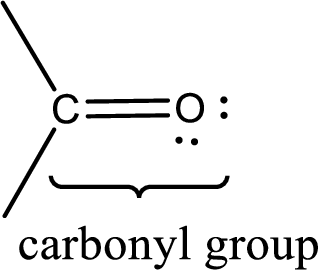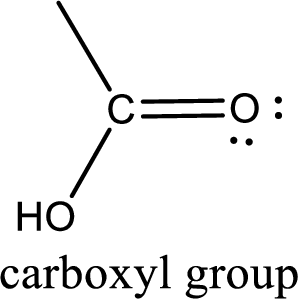
Organic And Biological Chemistry
7th Edition
ISBN: 9781305081079
Author: STOKER, H. Stephen (howard Stephen)
Publisher: Cengage Learning,
expand_more
expand_more
format_list_bulleted
Concept explainers
Question
Chapter 5.1, Problem 1QQ
Interpretation Introduction
Interpretation:
Concept Introduction:
Carbonyl groups are the one which contain a double bond between carbon and oxygen atom.

If a hydroxyl group is attached to a carbonyl group means it is known as carboxyl group. This can be represented as shown below,

Expert Solution & Answer
Want to see the full answer?
Check out a sample textbook solution
Students have asked these similar questions
Draw a Haworth projection or a common cyclic form of this monosaccharide:
H-
-OH
H-
OH
H-
-OH
CH₂OH
Answer the question in the first photo
Ggggffg2258555426855 please don't use AI
Calculate the positions at which the probability of a particle in a one-dimensional box is maximum if the particle is in the fifth energy level and in the eighth energy level.
Chapter 5 Solutions
Organic And Biological Chemistry
Ch. 5.1 - Prob. 1QQCh. 5.1 - Prob. 2QQCh. 5.1 - Prob. 3QQCh. 5.1 - Prob. 4QQCh. 5.1 - Prob. 5QQCh. 5.2 - Prob. 1QQCh. 5.2 - Prob. 2QQCh. 5.2 - Prob. 3QQCh. 5.2 - Prob. 4QQCh. 5.2 - Prob. 5QQ
Ch. 5.3 - Prob. 1QQCh. 5.3 - Prob. 2QQCh. 5.3 - Prob. 3QQCh. 5.4 - Prob. 1QQCh. 5.4 - Prob. 2QQCh. 5.4 - Prob. 3QQCh. 5.5 - Prob. 1QQCh. 5.5 - Prob. 2QQCh. 5.5 - Prob. 3QQCh. 5.6 - Prob. 1QQCh. 5.6 - Prob. 2QQCh. 5.7 - Which of the following statements about acid...Ch. 5.7 - Prob. 2QQCh. 5.7 - Prob. 3QQCh. 5.8 - Prob. 1QQCh. 5.8 - Prob. 2QQCh. 5.8 - Prob. 3QQCh. 5.8 - Prob. 4QQCh. 5.9 - Prob. 1QQCh. 5.9 - Prob. 2QQCh. 5.10 - Prob. 1QQCh. 5.10 - Prob. 2QQCh. 5.11 - Prob. 1QQCh. 5.11 - Prob. 2QQCh. 5.11 - Prob. 3QQCh. 5.12 - Prob. 1QQCh. 5.12 - Prob. 2QQCh. 5.12 - Prob. 3QQCh. 5.12 - Prob. 4QQCh. 5.13 - Prob. 1QQCh. 5.13 - Prob. 2QQCh. 5.14 - Prob. 1QQCh. 5.14 - Prob. 2QQCh. 5.14 - Prob. 3QQCh. 5.15 - Prob. 1QQCh. 5.15 - Prob. 2QQCh. 5.15 - Prob. 3QQCh. 5.16 - Prob. 1QQCh. 5.16 - Prob. 2QQCh. 5.16 - Prob. 3QQCh. 5.17 - Prob. 1QQCh. 5.17 - Prob. 2QQCh. 5.18 - Prob. 1QQCh. 5.18 - Prob. 2QQCh. 5.18 - Prob. 3QQCh. 5.19 - Prob. 1QQCh. 5.19 - Prob. 2QQCh. 5.19 - Prob. 3QQCh. 5.19 - Prob. 4QQCh. 5.20 - Prob. 1QQCh. 5.20 - Prob. 2QQCh. 5.20 - Prob. 3QQCh. 5.20 - Prob. 4QQCh. 5 - Prob. 5.1EPCh. 5 - Prob. 5.2EPCh. 5 - Prob. 5.3EPCh. 5 - Indicate whether or not each of the compounds in...Ch. 5 - Prob. 5.5EPCh. 5 - Prob. 5.6EPCh. 5 - Prob. 5.7EPCh. 5 - Prob. 5.8EPCh. 5 - Prob. 5.9EPCh. 5 - Prob. 5.10EPCh. 5 - Prob. 5.11EPCh. 5 - Prob. 5.12EPCh. 5 - Prob. 5.13EPCh. 5 - Prob. 5.14EPCh. 5 - Prob. 5.15EPCh. 5 - Assign an IUPAC name to each of the following...Ch. 5 - Prob. 5.17EPCh. 5 - Prob. 5.18EPCh. 5 - Prob. 5.19EPCh. 5 - Prob. 5.20EPCh. 5 - Prob. 5.21EPCh. 5 - Prob. 5.22EPCh. 5 - Prob. 5.23EPCh. 5 - Prob. 5.24EPCh. 5 - Prob. 5.25EPCh. 5 - Prob. 5.26EPCh. 5 - Prob. 5.27EPCh. 5 - Prob. 5.28EPCh. 5 - Prob. 5.29EPCh. 5 - Prob. 5.30EPCh. 5 - Prob. 5.31EPCh. 5 - Prob. 5.32EPCh. 5 - Prob. 5.33EPCh. 5 - Prob. 5.34EPCh. 5 - Prob. 5.35EPCh. 5 - Prob. 5.36EPCh. 5 - Prob. 5.37EPCh. 5 - Prob. 5.38EPCh. 5 - Prob. 5.39EPCh. 5 - Prob. 5.40EPCh. 5 - Determine the maximum number of hydrogen bonds...Ch. 5 - Prob. 5.42EPCh. 5 - Prob. 5.43EPCh. 5 - Prob. 5.44EPCh. 5 - Prob. 5.45EPCh. 5 - Prob. 5.46EPCh. 5 - Prob. 5.47EPCh. 5 - Prob. 5.48EPCh. 5 - Prob. 5.49EPCh. 5 - Prob. 5.50EPCh. 5 - Prob. 5.51EPCh. 5 - Prob. 5.52EPCh. 5 - Prob. 5.53EPCh. 5 - Prob. 5.54EPCh. 5 - Draw structural formulas for the following...Ch. 5 - Prob. 5.56EPCh. 5 - Give the IUPAC name for each of the following...Ch. 5 - Give the IUPAC name for each of the following...Ch. 5 - Prob. 5.59EPCh. 5 - Prob. 5.60EPCh. 5 - Prob. 5.61EPCh. 5 - Prob. 5.62EPCh. 5 - Prob. 5.63EPCh. 5 - Prob. 5.64EPCh. 5 - Prob. 5.65EPCh. 5 - Which three carboxylic acids have salts that are...Ch. 5 - Prob. 5.67EPCh. 5 - Which carboxylic acid has salts that are used to...Ch. 5 - Prob. 5.69EPCh. 5 - Prob. 5.70EPCh. 5 - Prob. 5.71EPCh. 5 - Prob. 5.72EPCh. 5 - Prob. 5.73EPCh. 5 - Prob. 5.74EPCh. 5 - Prob. 5.75EPCh. 5 - Prob. 5.76EPCh. 5 - Prob. 5.77EPCh. 5 - Prob. 5.78EPCh. 5 - Prob. 5.79EPCh. 5 - Prob. 5.80EPCh. 5 - Prob. 5.81EPCh. 5 - Prob. 5.82EPCh. 5 - Prob. 5.83EPCh. 5 - Prob. 5.84EPCh. 5 - Prob. 5.85EPCh. 5 - Prob. 5.86EPCh. 5 - Prob. 5.87EPCh. 5 - Prob. 5.88EPCh. 5 - Prob. 5.89EPCh. 5 - Prob. 5.90EPCh. 5 - Assign common names to each of the esters in...Ch. 5 - Prob. 5.92EPCh. 5 - Prob. 5.93EPCh. 5 - Assign an IUPAC name to each of the following...Ch. 5 - Draw a structural formula for each of the...Ch. 5 - Prob. 5.96EPCh. 5 - Prob. 5.97EPCh. 5 - Prob. 5.98EPCh. 5 - Prob. 5.99EPCh. 5 - Prob. 5.100EPCh. 5 - Prob. 5.101EPCh. 5 - How many carbon atoms are present in a molecule of...Ch. 5 - Prob. 5.103EPCh. 5 - Prob. 5.104EPCh. 5 - Prob. 5.105EPCh. 5 - Prob. 5.106EPCh. 5 - Prob. 5.107EPCh. 5 - Prob. 5.108EPCh. 5 - Prob. 5.109EPCh. 5 - Prob. 5.110EPCh. 5 - Prob. 5.111EPCh. 5 - Prob. 5.112EPCh. 5 - Prob. 5.113EPCh. 5 - Prob. 5.114EPCh. 5 - Prob. 5.115EPCh. 5 - Prob. 5.116EPCh. 5 - Prob. 5.117EPCh. 5 - Prob. 5.118EPCh. 5 - Prob. 5.119EPCh. 5 - Prob. 5.120EPCh. 5 - Prob. 5.121EPCh. 5 - Prob. 5.122EPCh. 5 - Prob. 5.123EPCh. 5 - Prob. 5.124EPCh. 5 - Write the structural formulas of the reaction...Ch. 5 - Prob. 5.126EPCh. 5 - Prob. 5.127EPCh. 5 - Prob. 5.128EPCh. 5 - Prob. 5.129EPCh. 5 - Prob. 5.130EPCh. 5 - Prob. 5.131EPCh. 5 - Prob. 5.132EPCh. 5 - Prob. 5.133EPCh. 5 - Prob. 5.134EPCh. 5 - Prob. 5.135EPCh. 5 - Prob. 5.136EPCh. 5 - Prob. 5.137EPCh. 5 - Prob. 5.138EPCh. 5 - Prob. 5.139EPCh. 5 - Prob. 5.140EPCh. 5 - Prob. 5.141EPCh. 5 - Prob. 5.142EPCh. 5 - Prob. 5.143EPCh. 5 - Prob. 5.144EPCh. 5 - Prob. 5.145EPCh. 5 - Prob. 5.146EPCh. 5 - Prob. 5.147EPCh. 5 - Prob. 5.148EPCh. 5 - Draw a condensed structural formula for the...Ch. 5 - Draw a condensed structural formula for the...Ch. 5 - Prob. 5.151EPCh. 5 - Prob. 5.152EPCh. 5 - Prob. 5.153EPCh. 5 - Prob. 5.154EPCh. 5 - Prob. 5.155EPCh. 5 - Prob. 5.156EPCh. 5 - Prob. 5.157EPCh. 5 - Prob. 5.158EPCh. 5 - Prob. 5.159EPCh. 5 - Prob. 5.160EPCh. 5 - Prob. 5.161EPCh. 5 - Prob. 5.162EPCh. 5 - Prob. 5.163EPCh. 5 - Prob. 5.164EP
Knowledge Booster
Learn more about
Need a deep-dive on the concept behind this application? Look no further. Learn more about this topic, chemistry and related others by exploring similar questions and additional content below.Similar questions
- Draw product A, indicating what type of reaction occurs. NH2 F3C CF3 NH OMe NH2-NH2, ACOH Aarrow_forwardPhotochemical smog is formed in part by the action of light on nitrogen dioxide. The wavelength of radiation absorbed by NO2 in this reaction is 197 nm.(a) Draw the Lewis structure of NO2 and sketch its π molecular orbitals.(b) When 1.56 mJ of energy is absorbed by 3.0 L of air at 20 °C and 0.91 atm, all the NO2 molecules in this sample dissociate by the reaction shown. Assume that each absorbed photon leads to the dissociation (into NO and O) of one NO2 molecule. What is the proportion, in parts per million, of NO2 molecules in this sample? Assume that the sample behaves ideally.arrow_forwardCorrect each molecule in the drawing area below so that it has the skeletal ("line") structure it would have if it were dissolved in a 0.1 M aqueous solution of HCI. If there are no changes to be made, check the No changes box under the drawing area. No changes. HO Explanation Check NH, 2 W O :□ G ©2025 M unter Accessibilityarrow_forward
- An expression for the root mean square velocity, vrms, of a gas was derived. Using Maxwell’s velocity distribution, one can also calculate the mean velocity and the most probable velocity (mp) of a collection of molecules. The equations used for these two quantities are vmean=(8RT/πM)1/2 and vmp=(2RT/M)1/2 These values have a fixed relationship to each other.(a) Arrange these three quantities in order of increasing magnitude.(b) Show that the relative magnitudes are independent of the molar mass of the gas.(c) Use the smallest velocity as a reference for establishing the order of magnitude and determine the relationship between the larger and smaller values.arrow_forwardThe reaction of solid dimethylhydrazine, (CH3)2N2H2, and liquefied dinitrogen tetroxide, N2O4, has been investigated for use as rocket fuel. The reaction produces the gases carbon dioxide (CO2), nitrogen (N2), and water vapor (H2O), which are ejected in the exhaust gases. In a controlled experiment, solid dimethylhydrazine was reacted with excess dinitrogen tetroxide, and the gases were collected in a closed balloon until a pressure of 2.50 atm and a temperature of 400.0 K were reached.(a) What are the partial pressures of CO2, N2, and H2O?(b) When the CO2 is removed by chemical reaction, what are the partial pressures of the remaining gases?arrow_forwardOne liter of chlorine gas at 1 atm and 298 K reacts completely with 1.00 L of nitrogen gas and 2.00 L of oxygen gas at the same temperature and pressure. A single gaseous product is formed, which fills a 2.00 L flask at 1.00 atm and 298 K. Use this information to determine the following characteristics of the product:(a) its empirical formula;(b) its molecular formula;(c) the most favorable Lewis formula based on formal charge arguments (the central atom is N);(d) the shape of the molecule.arrow_forward
- How does the square root mean square velocity of gas molecules vary with temperature? Illustrate this relationship by plotting the square root mean square velocity of N2 molecules as a function of temperature from T=100 K to T=300 K.arrow_forwardDraw product B, indicating what type of reaction occurs. F3C CF3 NH2 Me O .N. + B OMearrow_forwardBenzimidazole E. State its formula. sState the differences in the formula with other benzimidazoles.arrow_forward
arrow_back_ios
SEE MORE QUESTIONS
arrow_forward_ios
Recommended textbooks for you
 Organic And Biological ChemistryChemistryISBN:9781305081079Author:STOKER, H. Stephen (howard Stephen)Publisher:Cengage Learning,
Organic And Biological ChemistryChemistryISBN:9781305081079Author:STOKER, H. Stephen (howard Stephen)Publisher:Cengage Learning, General, Organic, and Biological ChemistryChemistryISBN:9781285853918Author:H. Stephen StokerPublisher:Cengage Learning
General, Organic, and Biological ChemistryChemistryISBN:9781285853918Author:H. Stephen StokerPublisher:Cengage Learning

Organic And Biological Chemistry
Chemistry
ISBN:9781305081079
Author:STOKER, H. Stephen (howard Stephen)
Publisher:Cengage Learning,

General, Organic, and Biological Chemistry
Chemistry
ISBN:9781285853918
Author:H. Stephen Stoker
Publisher:Cengage Learning